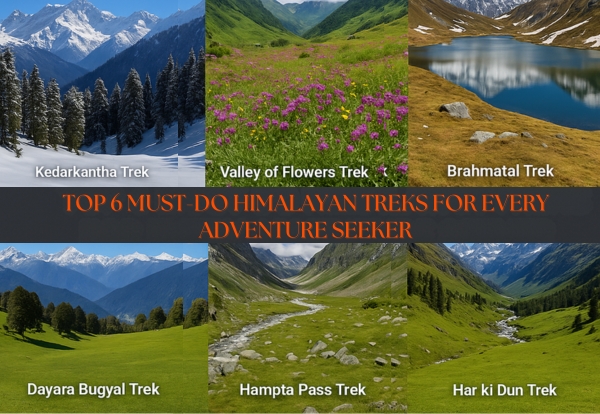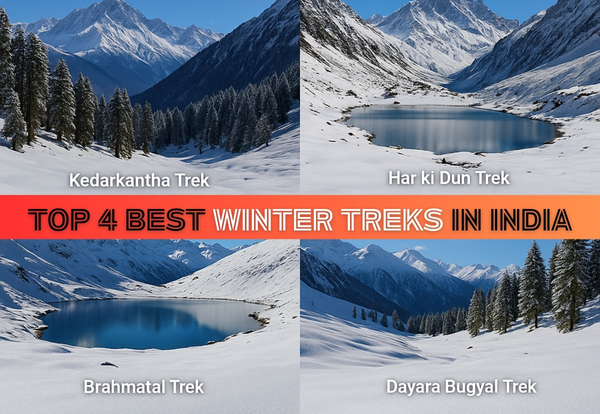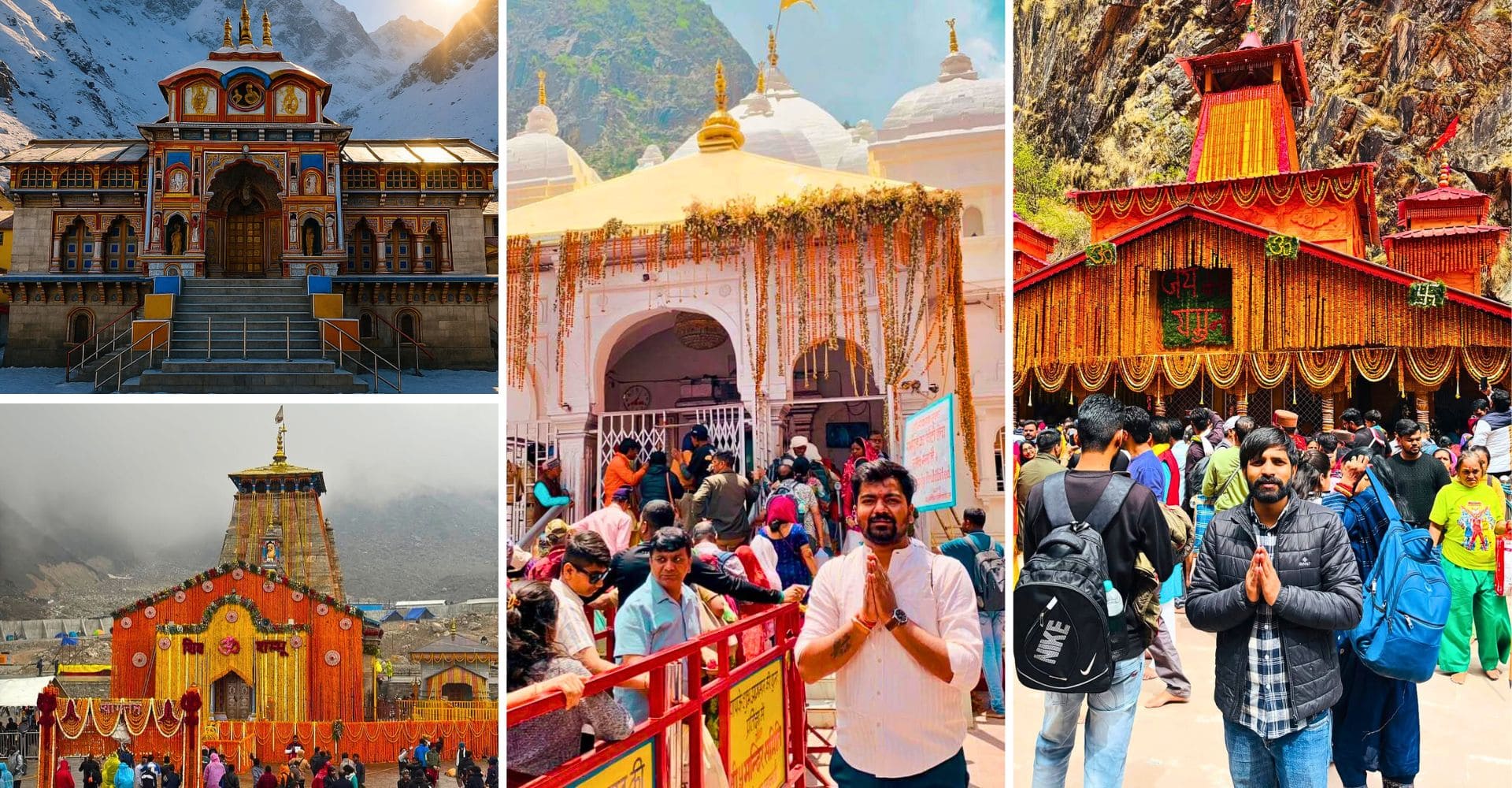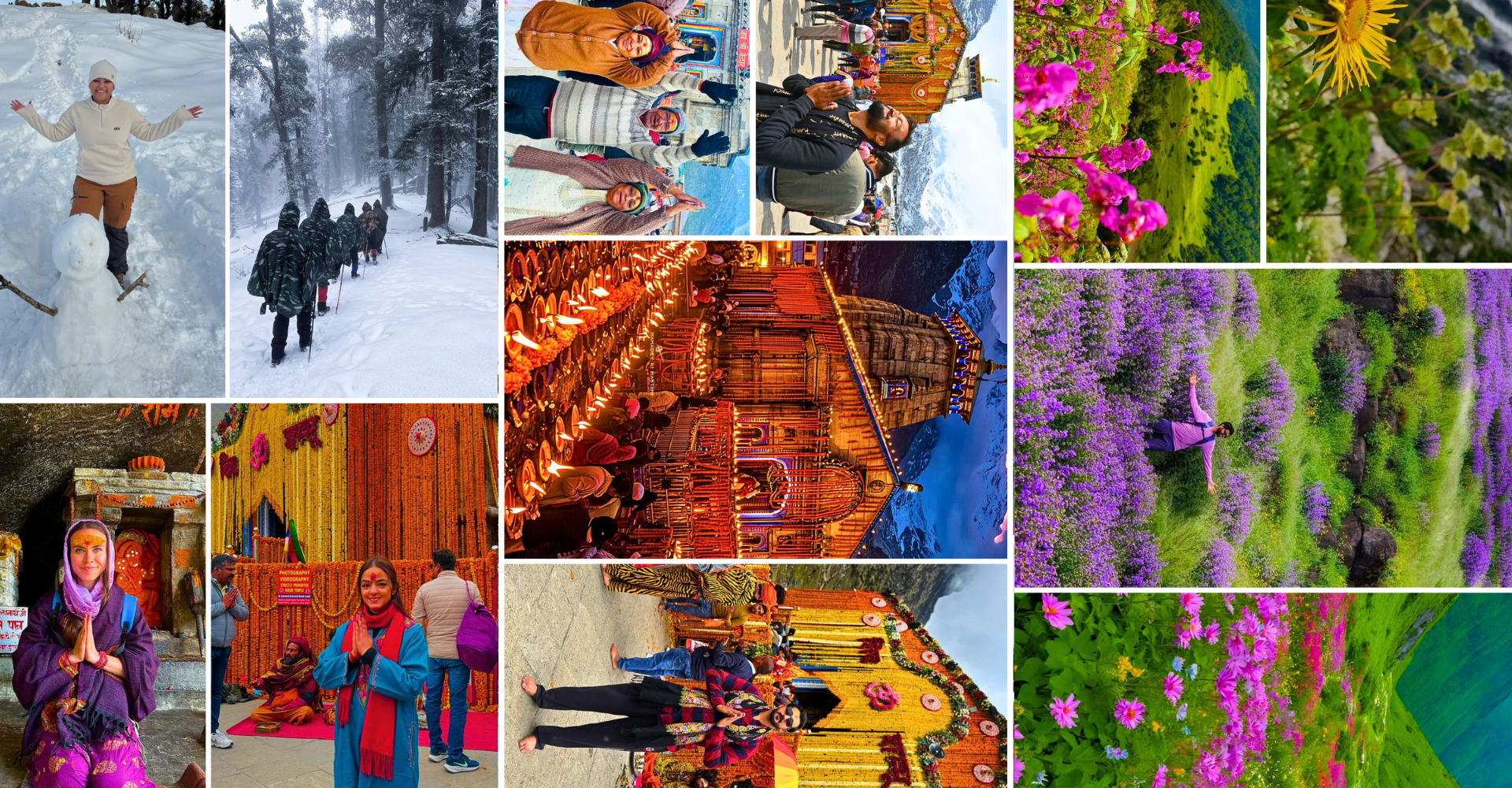Top 5 best trek in India
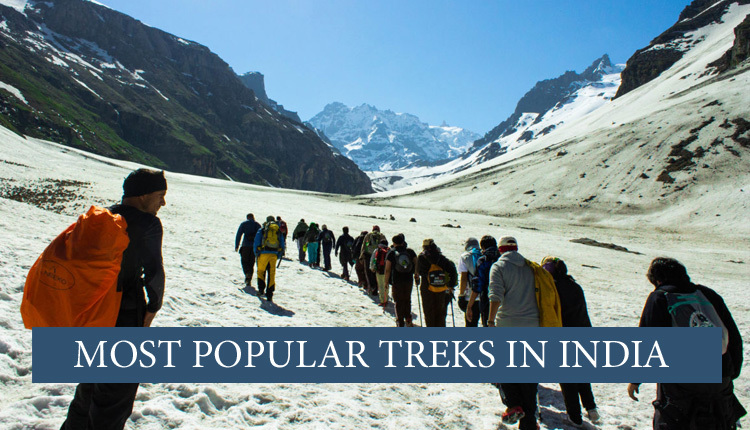
Introduction: Your Ultimate Guide to Kedarkantha Trek in 2025
The Kedarkantha Trek is one of the most sought-after treks in the Indian Himalayas, especially for trekkers looking for a combination of beauty, adventure, and accessibility. In 2025, it continues to be a top choice for beginners and experienced trekkers alike. This guide provides a complete overview of the Kedarkantha Trek 2025, including the route, difficulty level, best time to trek, and a detailed itinerary to help you plan the perfect Himalayan adventure.
1. Kedarkantha Trek Route: A Scenic Journey through the Himalayas
The Kedarkantha Trek follows a picturesque route that takes trekkers through dense forests, beautiful meadows, and snow-covered trails. Starting from Sankri, the trek weaves its way up to Kedarkantha Base Camp and ultimately to the summit. Along the way, trekkers pass through Juda Ka Talab, a serene pond, and various scenic spots that offer breathtaking views of the surrounding mountains. The route is well-marked, making it easy for trekkers to follow.
Key Highlights of the Route:
Sankri to Juda Ka Talab: Begin your trek through charming villages and dense forests.
Juda Ka Talab to Kedarkantha Base Camp: Ascend through snow-covered terrain and reach the base camp for a restful night.
Kedarkantha Base Camp to Summit: The final ascent to the summit offers stunning views of the snow-covered peaks.
2. Difficulty Level: A Moderate Trek for All Experience Levels
The Kedarkantha is considered a moderate trek, making it an ideal choice for trekkers with basic fitness levels. The trek involves a gradual climb, allowing trekkers to adjust to the altitude. While it’s not technically challenging, the steep final ascent to the summit may require some effort. The trek is perfect for beginners, but those with some prior trekking experience will find it equally rewarding.
Difficulty Level: Moderate
Duration: 6 Days
Altitude: 12,500 feet (Summit)
3. Best Time for Kedarkantha Trek: When to Experience Its Full Glory
The best time to do the Kedarkantha Trek in Uttarakhand is during the winter months, from December to February, when the region is covered in snow. The views are stunning, and the trails are perfect for a snow trek. However, for those who prefer less snow and milder temperatures, the pre-winter season (March-April) also offers a great experience with clear skies and lush green landscapes.
Best Seasons to Trek:
Winter Season (December to February): Ideal for snow trekking and experiencing the winter wonderland.
Pre-Summer (March-April): Great for moderate temperatures and green landscapes.
4. Kedarkantha Trek Itinerary: Plan Your Trek to Perfection
The Kedarkantha Trek itinerary is designed to ensure an enjoyable and safe trekking experience. Here’s a breakdown of what to expect on each day of the trek.
Day 1: Drive from Dehradun to Sankri
Start your journey with a scenic drive from Dehradun to Sankri, the base camp of the trek. This drive takes around 8–10 hours and offers beautiful views of the Uttarakhand landscape.
Day 2: Sankri to Juda Ka Talab
Your first trekking day takes you from Sankri to Juda Ka Talab (2,200 meters). The route is relatively easy, passing through pine forests and small villages. The campsite near Juda Ka Talab offers a stunning view of the surrounding mountains.
Day 3: Juda Ka Talab to Kedarkantha Base Camp
On day 3, trek from Juda Ka Talab to Kedarkantha Base Camp (3,600 meters). The climb is slightly steeper, but the views of the snowy peaks and the journey through dense forests make it an unforgettable experience.
Day 4: Kedarkantha Base Camp to Summit and Back
This is the most challenging day of the trek. You will start early in the morning to reach the Kedarkantha Summit (3,800 meters). The ascent is steep, but once at the top, you’ll be rewarded with a panoramic view of peaks like Swargarohini, Kalanag, and Black Peak. After spending some time at the summit, descend to the base camp for a restful night.
Day 5: Kedarkantha Base Camp to Sankri
On this day, descend back to Sankri from the base camp. The return journey is relatively easy, and you’ll pass through the same beautiful scenery you encountered earlier in the trek.
Day 6: Return to Dehradun
On the final day, take a drive from Sankri back to Dehradun, where your adventure comes to an end.
5. Kedarkantha Trek Package: What’s Included
When booking a Kedarkantha Trek Package, most packages include the following:
Transportation from Dehradun to Sankri and back.
Guides who are well-versed with the route and safety protocols.
Camping equipment, including tents, sleeping bags, and mattresses.
Meals during the trek, ensuring you are fueled and ready for the journey.
Trekking permits and necessary paperwork.
These packages are designed to make your trek comfortable and hassle-free, so you can focus on enjoying the adventure.
6. Why Kedarkantha Trek Should Be on Your List for 2025
The Kedarkantha Trek in 2025 promises to be an unforgettable experience. Whether you're a beginner looking for your first Himalayan trek or an experienced adventurer seeking a winter wonderland, the Kedarkantha Trek offers something for everyone. Its moderate difficulty, stunning views, and well-organized trekking packages make it a top choice for trekkers in 2025.
Har Ki Dun Trek 2025: Best Time, Trail Map, and Travel Tips
Introduction
Nestled in the cradle of the Garhwal Himalayas, the Har Ki Dun Trek is one of India’s most picturesque and spiritually significant trails. If you're planning your Himalayan escape in 2025, this comprehensive guide gives you all the insights you need: the best time to go, a detailed trail map, and travel tips to make your trek smooth and memorable.
Why Har Ki Dun Should Be on Your 2025 Trekking List
Unlike many over-commercialized treks, Har Ki Dun offers a blend of scenic beauty, mythological allure, and cultural richness. From the sacred Swargarohini Peaks to the untouched villages of Osla and Gangad, every corner of this valley whispers stories of ancient India.
Best Time to Visit Har Ki Dun Trek in Uttarakhand
Timing can make or break your trekking experience. Here’s how each season plays out in Har Ki Dun Trek in Uttarakhand:
1. Spring (March to April)
Lush forests awakening from winter
Snow still visible in upper trails
Fewer crowds and blooming rhododendrons
2. Summer (May to June)
Clear skies, warm days, cool nights
Ideal for families and first-time trekkers
Streams and waterfalls at their best
3. Post-Monsoon (September to mid-November)
Vibrant meadows and golden forests
Excellent visibility for photography
Perfect for witnessing Himalayan biodiversity
4. Winter (December to February) (for pros only)
Heavy snow, blocked trails
Requires technical gear and guides
Not recommended for casual trekkers
➡ Pro Tip: The best time for the Har Ki Dun Trek Package is from April to June and September to mid-November for ideal weather, views, and accessibility.
Trail Map & Route Breakdown
Start Point: Sankri Village (6,400 ft)
Max Altitude: 11,700 ft approx.
Total Distance: ~44 km round trip
Trek Duration: 6–7 days
Day-wise Itinerary:
Day 1: Dehradun → Sankri (Drive: 200 km)
Day 2: Sankri → Taluka → Seema (Trek: 14 km)
Day 3: Seema → Osla → Har Ki Dun Valley (Trek: 12 km)
Day 4: Explore Har Ki Dun → Marinda Tal (Optional 4 km trek)
Day 5: Har Ki Dun → Seema (Return Trek)
Day 6: Seema → Taluka → Sankri
Day 7: Sankri → Dehradun (Return journey)
Each day unveils new scenery—from pine forests and river crossings to alpine valleys and snowfields.
What Makes the Trail Unique?
Historic Villages: Osla and Gangad offer rare glimpses of ancient Himalayan lifestyle.
Swargarohini Views: These mythological peaks are said to be the stairway to heaven.
Govind National Park: Home to Himalayan Monals, bears, and orchids.
No Tech Zone: A perfect detox with no mobile signals or WiFi.
Travel Tips for 2025 Trekkers
✔ Book Your Slot in Advance
Due to increased popularity and limited batch sizes, book your Har Ki Dun Trek Package at least 2 months in advance.
✔ Train Your Body
Although graded moderate, you’ll need stamina for 6-7 hours of trekking per day. Include cardio and strength training in your prep.
✔ Acclimatize Properly
Spend a day in Sankri before starting the trek. Avoid rushing to higher altitudes.
✔ Carry These Essentials
High-ankle trekking shoes
UV-protection sunglasses and sunscreen
Thermals, fleece, and windproof jackets
Headlamp, raincover, and quick-dry towels
Power bank, ID cards, and permits
Accommodation & Food on the Trail
Stay Options: Homestays in Osla and tents in Har Ki Dun
Food: Mostly vegetarian, local Garhwali meals
Toilets: Dry pit toilets at campsites
Electricity: No power beyond Sankri—carry solar chargers or battery banks
Connectivity and How to Reach Sankri
✈ By Air:
Nearest Airport: Jolly Grant Airport, Dehradun (210 km from Sankri)
🚆 By Train:
Dehradun Railway Station connects to major cities like Delhi, Mumbai, and Kolkata.
🚌 By Road:
Regular buses from Dehradun to Purola/Mori
Shared taxis available from Purola to Sankri
Local Culture and Etiquette
Har Ki Dun is home to the warm and welcoming Garhwali people. Respect local traditions:
Don’t litter or pluck flowers
Avoid loud music and drones
Always ask before photographing villagers or homes
Greet locals with “Namaste” and a smile
Environmental Responsibility
Help keep this Himalayan gem pristine:
Use refillable water bottles
Carry your own garbage bags
Avoid plastic and packaged junk food
Follow Leave No Trace principles
Transportation from Dehradun to Sankri
Accommodation and meals
Trek permits and entry fees
Professional trek guide and support staff
Excludes:
Personal gear (shoes, jackets, etc.)
Extra snacks, bottled water, or special items
Travel insurance
What to Expect in 2025 – Trends & Updates
More Eco-Treks: Sustainable camping and solar gear are in trend
Group Treks for Women: Dedicated women-only trek groups are increasing
Digital Detox Packages: Agencies offering meditation and mindfulness activities
High Demand: With Har Ki Dun gaining fame, early bookings and permits will be essential in 2025
Final Thoughts: Why Wait? Make Har Ki Dun Your Next Adventure
The Har Ki Dun Trek in Uttarakhand isn’t just a hike—it’s a harmonious blend of natural beauty, spirituality, culture, and challenge. Whether you're a first-timer or a seasoned trekker, this trail promises serenity, stunning views, and soul-stirring stories.
Make 2025 the year you explore this hidden treasure of the Himalayas. Book your Har Ki Dun Trek Package and step into the valley where legends still live, and nature sings in silence.
Top 7 Reasons to Add the Valley of Flowers Trek to Your Bucket List
Introduction: Why the Valley of Flowers Trek Should Be on Your Bucket List
The Valley of Flowers Trek is one of the most stunning trekking routes in India, offering a perfect blend of adventure and natural beauty. Whether you’re a seasoned trekker or a nature enthusiast, the trek offers something for everyone. Here are the top 7 reasons why the Valley of Flowers Trek should be on your bucket list.
1. Experience the Vibrant Colors of the Valley
The Valley of Flowers is known for its breathtaking display of colors. The valley is home to over 500 species of wildflowers, creating a visual feast that will leave you mesmerized. Whether it’s the blue poppy, the Himalayan primrose, or the Siberian iris, the colors are truly a sight to behold.
2. Trek Through a UNESCO World Heritage Site
As a UNESCO World Heritage Site, the Valley of Flowers is a protected area, preserving its natural beauty and biodiversity. The trek offers a chance to walk through a region of immense ecological value, home to rare plants, wildlife, and natural wonders.
3. Ideal for All Levels of Trekkers
The Valley of Flowers Trek in Uttarakhand is moderate in difficulty, making it accessible to trekkers of all levels. Whether you're a beginner or an experienced trekker, the trail provides a perfect mix of challenge and scenic rewards.
4. Capture Stunning Photographs
The beauty of the Valley of Flowers makes it a photographer’s dream. The flowers, landscapes, and wildlife present unique opportunities to capture breathtaking photos that will stay with you long after the trek is over.
5. A Peaceful Escape from City Life
If you’re looking to disconnect from the hustle and bustle of everyday life, the Valley of Flowers Trek offers a peaceful retreat. With its serene landscapes, cool mountain air, and tranquil environment, it’s the perfect place to relax and unwind.
6. Explore Rich Flora and Fauna
The valley is home to over 500 species of flowers and a variety of wildlife, including the Himalayan Monal, Musk Deer, and Himalayan Black Bear. Trekking through the valley offers a chance to witness these rare species in their natural habitat.
7. Make Unforgettable Memories
Ultimately, the Valley of Flowers Trek is a journey that will stay with you forever. From the first step you take into the valley to the final glance back at the stunning Himalayan peaks, this trek offers memories that will last a lifetime.
Conclusion: Start Your Adventure Today
The Valley of Flowers Trek is one of the most extraordinary treks you can undertake in India. With its stunning beauty, rich biodiversity, and challenging yet accessible trails, it’s no wonder that it’s on every trekker’s bucket list. Book your Valley of Flowers Trek Package now and embark on the adventure of a lifetime!
Top 7 Reasons Every Trekker Should Experience the Hampta Pass Trek
Introduction: Why Hampta Pass Trek is a Must-Do for Every Trekker
The Hampta Pass Trek is more than just a journey; it’s an adventure of a lifetime. From breathtaking landscapes to challenging terrain, here are the top 7 reasons why every trekker should experience this Himalayan marvel.
1. Spectacular Views of the Himalayas
The Hampta Pass Trek offers unparalleled views of the Himalayas. The towering peaks of Deo Tibba, Hanuman Tibba, and Indrasan provide a stunning backdrop as you trek through lush meadows and rocky terrains.
2. Unique Landscape Transition
The Hampta Pass stands out for its contrast of landscapes. Starting in the green, fertile Kullu valley, you’ll gradually make your way to the barren Spiti Valley, offering a dramatic shift in scenery that is unlike any other trek.
3. A Moderate Challenge for All Skill Levels
Whether you’re a beginner or an experienced trekker, the Hampta Pass Trek offers a moderate level of difficulty that will challenge your endurance without being overwhelming. The trek is ideal for those looking to push their limits without needing to be an expert mountaineer.
4. Perfect Camping Sites
From Chika to Balu ka Ghera, the trek offers some of the best camping experiences in the Himalayas. Surrounded by snow-capped mountains, pristine lakes, and alpine meadows, each campsite provides a serene atmosphere to relax and enjoy the natural beauty.
5. The Thrill of Crossing Hampta Pass
At 14,000 feet, Hampta Pass is an exhilarating challenge. The view from the top is worth every step, as trekkers are treated to 360-degree views of the Himalayas, including both Kullu Valley and Spiti.
6. Ideal Trek for Nature Lovers
The trek is rich in biodiversity, with the surrounding forests home to species like Himalayan Monal, snow leopards, and a variety of alpine flowers. Nature lovers will find ample opportunities to explore and photograph the stunning flora and fauna along the way.
7. Escape into the Heart of the Himalayas
Finally, the Hampta Pass Trek offers a true escape into nature’s untouched beauty. Away from the hustle and bustle of daily life, this trek provides solitude, peace, and the chance to reconnect with nature in its most pristine form.
What’s Included in a Hampta Pass Trek Package?
When you book a Hampta Pass Trek Package, you can expect the following inclusions:
Experienced guides and trekkers
Meals during the trek (breakfast, lunch, dinner)
Camping equipment (tents, sleeping bags, etc.)
Transport to and from Manali
Permits and insurance
First-aid and emergency support
Conclusion: A Trek for Every Adventurer
The Hampta Pass Trek in Himachal is more than just a physical challenge; it’s an opportunity to experience the Himalayas in all their grandeur. With its diverse landscapes, moderate difficulty, and stunning views, it’s a trek that should be on every adventurer’s bucket list.
Is the Sar Pass Trek Safe? Here’s What Every Trekker Should Know
Introduction: Safety First on the Snow Trails
The Sar Pass Trek is one of the most scenic and accessible snow treks in Himachal. But before stepping into the serene snowfields, understanding the risks, weather conditions, and safety protocols is essential. If you’re planning to book a Sar Pass Trek Package, this guide ensures you do it safely and confidently.
Is Sar Pass Trek Safe for Beginners?
Yes, with proper preparation. The Sar Pass Trek in Himachal is graded as moderate in difficulty:
Suitable for first-timers with decent fitness
Well-guided and organized routes
Good safety records with reputed trek organizers
Avoid trekking solo, especially during snow or rain.
Challenges You Might Face
Altitude Sickness: Trek crosses 13,800 ft. Acclimatize well.
Weather Shifts: Sudden snow, rain, or strong winds
Slippery Trails: Especially from Nagaru to Sar Pass
Limited Network: No phone coverage after Grahan
These are manageable if you follow your guide’s instructions.
How to Prepare for Sar Pass Trek Safety
Fitness Prep: Start cardio and leg exercises at least 1 month before
Gear Up: Trekking shoes, layered clothing, walking stick
Emergency Readiness: Carry ORS, painkillers, and prescribed medicines
Travel Insurance: Recommended for any Sar Pass Trek Package
Safety Measures Taken by Trek Organizers
Trained trek leaders with first-aid certification
Oxygen cylinders and stretchers at high camps
Weather monitoring and alternate plans
Briefings and medical checks before the trek
Choose reliable companies like Hello Hikers that follow high safety standards.
Best Time to Go for a Safer Experience
May to Mid-June: Fresh snow, clear trails, stable weather
Avoid monsoon season (July-August) due to landslides and slippery paths
This window offers the safest and most scenic Sar Pass Trek experience.
What to Do in Case of Emergency
Inform your trek leader immediately
Avoid panic and follow instructions
Don’t try to descend or ascend without guidance
Being calm and cooperative is the key to safety in high-altitude emergencies.
Final Safety Tips for Sar Pass Trek
Pack light but don’t skip essentials
Stay hydrated and take regular breaks
Don’t litter or disturb local wildlife
Carry valid ID and emergency contact info
Conclusion: Adventure with Awareness
The Sar Pass Trek is undoubtedly safe when done responsibly. With the right mindset, preparation, and a trustworthy Sar Pass Trek Package, even first-timers can conquer this Himalayan wonder without worry. Always prioritize safety, because every view is more beautiful when you reach it safely.
Note: IndiBlogHub features both user-submitted and editorial content. We do not verify third-party contributions. Read our Disclaimer and Privacy Policyfor details.



